
Home - Search - Browse - Alphabetic Index: 0- 1- 2- 3- 4- 5- 6- 7- 8- 9
A- B- C- D- E- F- G- H- I- J- K- L- M- N- O- P- Q- R- S- T- U- V- W- X- Y- Z
STS-41-B

STS-41-B
Aerial view of the Vehicle Assembly Building and associated complex
Credit: NASA
AKA: Challenger. Launched: 1984-02-03. Returned: 1984-02-11. Number crew: 5 . Duration: 7.97 days.
Payloads: PALAPA-B2 (Indonesian communications satellite) with Payload Assist Module (PAM)-D and WESTAR (Western Union communications satellite)-VI with PAM-D. Both satellites were deployed but the PAM-D in each satellite failed to ignite, leaving both satellites in earth orbit. Both satellites were retrieved and returned to earth for renovation on the STS-51-A mission. The manned maneuvering unit (MMU) was tested with extravehicular astronauts as free flyers without tethers as far as 98 m from the orbiter. Shuttle Pallet Satellite (SPAS)-01 experiments, Monodisperse Latex Reactor (MLR), Isoelectric Focusing Experiment (IEF), Acoustic Containerless Experiment System (ACES), Cinema 360 cameras, five getaway specials (GAS), Aerodynamic Coefficient Identification (ACIP)/High Resolution Accelerometer Package (HIRAP).
Orbits of Earth: 127. Distance traveled: 5,329,147 km. Orbiter Liftoff Mass: 113,527 kg. Orbiter Mass at Landing: 91,278 kg. Payload to Orbit: 15,362 kg. Payload Returned: 8,620 kg. Landed at: Runway 15 at Kennedy Space Center, Florida. Landing Speed: 363 kph. Touchdown miss distance: 585 m. Landing Rollout: 3,296 m. EVA: Bruce McCandless and Robert Stewart. EVA No. 1 duration 5 hours, 35 minutes, EVA No. 2 duration 6 hours, 2 minutes. First flight of the manned maneuvering unit (MMU). Bruce McCandless operating time one hour, 55 minutes; Robert Stewart, 44 minutes.
NASA Official Mission Narrative
Mission Name: 41-B (10)
CHALLENGER (4)
Pad 39-A (22)
10th Shuttle mission
4th Flight OV-099
1st KSC landing
Crew:
Vance D. Brand (3), Commander
Robert L. Gibson (1), Pilot
Bruce McCandless II (1), Mission Specialist
Ronald E. McNair (1), Mission Specialist
Robert L. Stewart (1), Mission Specialist
Milestones:
OPF - Sept. 10, 1983
VAB - Jan.6, 1984
PAD - Jan. 12, 1984
Payload:
PALAPA-B2,WESTAR-6,ACES,IEF,RME,MLR(4),SSIP(x1),IRT,GAS(x5)
Mission Objectives:
Launch:
February 3, 1984, 8:00:00 a.m, EST. Launch set for Jan. 29 postponed five days while orbiter still in OPF to allow changeout of all three auxiliary power units (APUs), a precautionary measure in response to APU failures on previous STS-9 mission. Launch Weight: 250,452 lbs.
Orbit:
Altitude: 189nm
Inclination: 28.5 degrees
Orbits: 128
Duration: 7 days, 23 hours, 15 minutes, 55 seconds.
Distance: 3,311,380 miles
Hardware:
SRB: BI-010
SRM: 010MW(HPM)
ET : 10/LWT-3
MLP : 2
SSME-1: SN-2109
SSME-2: SN-2015
SSME-3: SN-2012
Landing:
February 11, 1984, 7:15:55 a.m, EST, Runway 15, Kennedy Space Center, Fla. Rollout distance: 10,815 feet. Rollout time: 67 seconds. First end-of-mission landing at KSC. Landing Weight: 201,238 lbs.
Mission Highlights:
First untethered space walks by McCandless and Stewart, using manned maneuvering unit. WESTAR-VI and PALAPA-B2 satellites deployed, but failure of Payload Assist Module-D (PAM-D) rocket motors left them in radical low-Earth orbits. German-built Shuttle Pallet Satellite (SPAS), first flown on STS-7, became first satellite refurbished and flown again. SPAS remained in payload bay due to electrical problem with Remote Manipulator System (RMS). RMS manipulator foot restraint first used, practice procedures performed for Solar Maximum satellite retrieval and repair planned for next mission. Integrated Rendezvous Target (IRT) failed due to internal failure. Five Get Away Special canisters flown in cargo bay and Cinema-360 camera used by crew. Other payloads: Acoustic Containerless Experiment System (ACES); Monodisperse Latex Reactor (MLR); and Radiation Monitoring Equipment (RME), and Isoelectric Focusing (IEF) payload.
More at: STS-41-B.
Family: Manned spaceflight. People: Brand, Gibson, McCandless, McNair, Stewart. Country: USA. Spacecraft: Challenger. Projects: STS. Launch Sites: Cape Canaveral. Agency: NASA, NASA Houston.
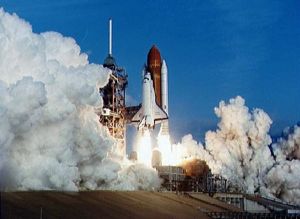 | STS-41-B Views of the STS-11 launch from pad 39A on Feb. 3, 1984 Credit: NASA |
 | STS-41-B View of the Challenger from the fixed camera in McCandless's helmet Credit: NASA |
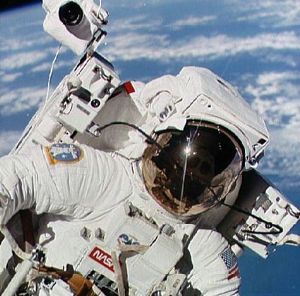 | STS-41-B Close-up view of Astronaut McCandless during his EVA Credit: NASA |
 | STS-41-B View of the Challenger from the fixed camera in McCandless's helmet Credit: NASA |
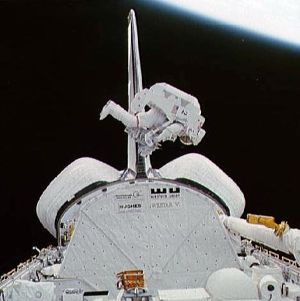 | STS-41-B View of Astronaut Bruce McCandless during EVA Credit: NASA |
 | STS-41-B View of retrieval of foot restraint which strayed from Challenger Credit: NASA |
 | STS-41-B Astronauts McNair and Stewart prepare for re-entry Credit: NASA |
 | STS-41-B View of the Palapa-B and the Shuttle Challenger after deployment Credit: NASA |
 | STS-41-B View of Astronaut Bruce McCandless during EVA Credit: NASA |
 | STS-41-B Views of the extravehicular activity during STS 41-B Credit: NASA |
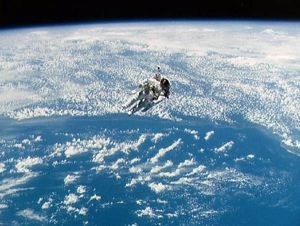 | STS-41-B Views of the extravehicular activity during STS 41-B Credit: NASA |
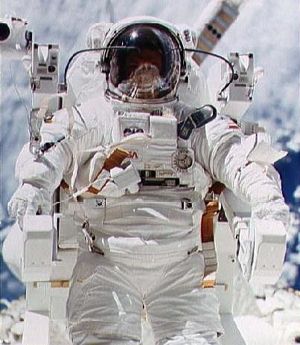 | STS-41-B Views of the extravehicular activity of Astronaut Stewart during STS 41-B Credit: NASA |
 | STS-41-B Views of the extravehicular activity during STS 41-B Credit: NASA |
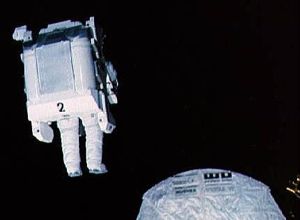 | STS-41-B Views of the extravehicular activity during STS 41-B Credit: NASA |
 | STS-41-B View of Astronaut Bruce McCandless during EVA Credit: NASA |
 | STS-41-B View of Astronaut Bruce McCandless during EVA Credit: NASA |
 | STS-41-B View of Astronaut Bruce McCandless during EVA Credit: NASA |
 | STS-41-B Views of the Challenger landing at Kennedy to end shuttle mission 41-B Credit: NASA |
1984 February 3 - . 13:00 GMT - . Launch Site: Cape Canaveral. Launch Complex: Cape Canaveral LC39A. Launch Platform: MLP2. LV Family: Shuttle. Launch Vehicle: Space Shuttle.
- STS-41-B - .
Call Sign: Challenger. Crew: Brand,
Gibson,
McCandless,
McNair,
Stewart.
Payload: Challenger F04 / SPAS 1A. Mass: 15,362 kg (33,867 lb). Nation: USA.
Related Persons: Brand,
Gibson,
McCandless,
McNair,
Stewart.
Agency: NASA Houston.
Program: STS.
Class: Manned.
Type: Manned spaceplane. Flight: STS-41-B.
Spacecraft Bus: Shuttle.
Spacecraft: Challenger.
Duration: 7.97 days. Decay Date: 1984-02-11 . USAF Sat Cat: 14681 . COSPAR: 1984-011A. Apogee: 316 km (196 mi). Perigee: 307 km (190 mi). Inclination: 28.50 deg. Period: 90.80 min.
Manned five crew. Deployed Westar 6, Palapa B2; tested Manned Maneuvering Unit (MMU). Payloads: PALAPA-B2 (Indonesian communications satellite) with Payload Assist Module (PAM)-D and WESTAR (Western Union communications satellite)-Vl with PAM-D. Both satellites were deployed but the PAM-D in each satellite failed to ignite, leaving both satellites in earth orbit. Both satellites were retrieved and returned to earth for renovation on the STS-51-A mission. The manned maneuvering unit (MMU) was tested with extravehicular astronauts as free flyers without tethers as far as 98 m from the orbiter. Shuttle Pallet Satellite (SPAS)-01 experiments, Monodisperse Latex Reactor (MLR), Isoelectric Focusing Experiment (lEF), Acoustic Containerless Experiment System (ACES), Cinema 360 cameras, five getaway specials (GAS), Aerodynamic Coefficient Identification (ACIP)/High Resolution Accelerom-eter Package (HIRAP).
1984 February 4 - .
- STS-41-B - Wakeup Song: Contraband - . Flight: STS-41-B. "Contraband" music selection by that group of NASA employees and would have featured Ron McNair, astronaut Ron McNair on the tenor sax, but that somehow got garbled in the translation going up..
1984 February 5 - .
- STS-41-B - Wakeup Song: A Train - . Flight: STS-41-B. "A Train" by"Contraband" which features as its tenor sax player, Dr. Ron McNair.
1984 February 6 - .
- STS-41-B - Wakeup Song: Glory, Glory, Colorado - .
Flight: STS-41-B.
"Glory, Glory, Colorado" by the University of Colorado Band. That's the fight song of that institution which is Vance Brand's alma mater followed by"Ride High You Mustangs" the Cal Poly State University fight song which is Pilot Robert Gibson's alma mater.
1984 February 7 - .
- STS-41-B - Wakeup Song: Armed forces medley - .
Flight: STS-41-B.
"Armed forces medley" which covered three of the services. The Marine Corp., of course is Vance Brand's alma mater. He's now a civilian but was originally trained as a Marine Corps pilot. The Navy hymn in honor of Mission Specialist, Bruce McCandless and Challenger Pilot, Hoot Gibson, both Naval Officers. And the Army song honoring the nation's first United States Army Astronaut, Bob Stewart. And the music was performed by guess who, the U.S. Air Force Academy Chorale.
1984 February 8 - .
- STS-41-B - Wakeup Song: North Carolina A&T University alma mater - . Flight: STS-41-B. "North Carolina A&T University alma mater" of which Mission Specialist Ron McNair is an alumnus and"Southern to the Top", the fight song from the University of Southern Mississippi, the alma mater of Mission Specialist Bob Stewart..
1984 February 9 - .
- STS-41-B - Wakeup Song: Theme from 'The Greatest American Hero' - . Flight: STS-41-B. "Theme from 'The Greatest American Hero'" in honor of EVA. With some changed verses.
1984 February 10 - .
- STS-41-B - Wakeup Song: Off We Go Into the Wild Blue Yonder - . Flight: STS-41-B. "Off We Go Into the Wild Blue Yonder" ) a live rendition of The Air Force Song from all the Air Force CAPCOMs..
1984 February 11 - .
- STS-41-B - Wakeup Song: In the Mood - . Flight: STS-41-B. "In the Mood" by"Contraband", a musical group composed of JSC employees..
1984 February 11 - .
- Landing of STS-41-B - . Return Crew: Brand, Gibson, McCandless, McNair, Stewart. Nation: USA. Related Persons: Brand, Gibson, McCandless, McNair, Stewart. Program: STS. Flight: STS-41-B. STS-41-B landed at 12:15 GMT. .
Back to top of page
Home - Search - Browse - Alphabetic Index: 0- 1- 2- 3- 4- 5- 6- 7- 8- 9
A- B- C- D- E- F- G- H- I- J- K- L- M- N- O- P- Q- R- S- T- U- V- W- X- Y- Z
© 1997-2019 Mark Wade - Contact
© / Conditions for Use